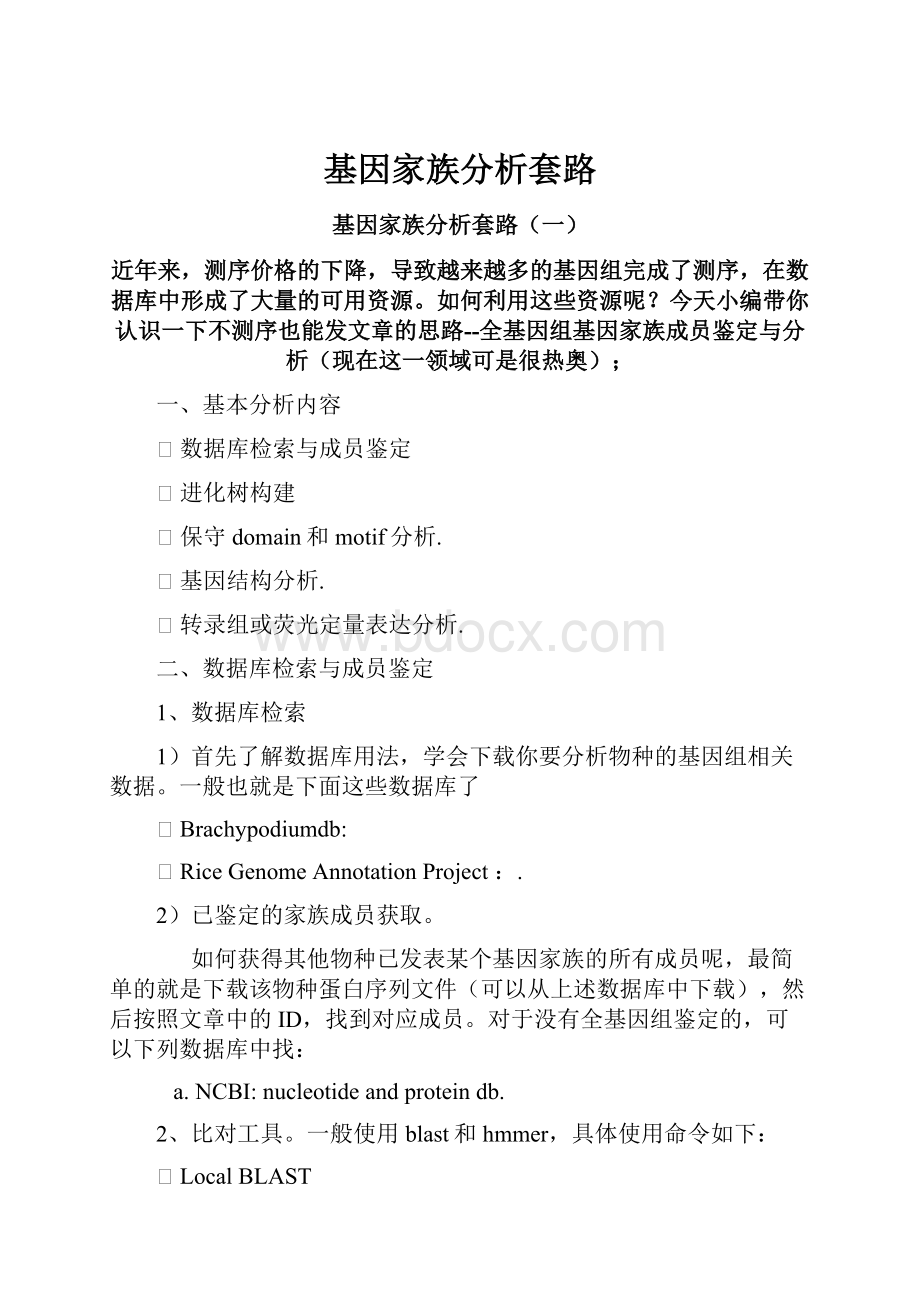 基因家族分析套路.docx
基因家族分析套路.docx
- 文档编号:10323604
- 上传时间:2023-02-10
- 格式:DOCX
- 页数:9
- 大小:604.69KB
基因家族分析套路.docx
《基因家族分析套路.docx》由会员分享,可在线阅读,更多相关《基因家族分析套路.docx(9页珍藏版)》请在冰豆网上搜索。

基因家族分析套路
基因家族分析套路
(一)
近年来,测序价格的下降,导致越来越多的基因组完成了测序,在数据库中形成了大量的可用资源。
如何利用这些资源呢?
今天小编带你认识一下不测序也能发文章的思路--全基因组基因家族成员鉴定与分析(现在这一领域可是很热奥);
一、基本分析内容
⏹数据库检索与成员鉴定
⏹进化树构建
⏹保守domain和motif分析.
⏹基因结构分析.
⏹转录组或荧光定量表达分析.
二、数据库检索与成员鉴定
1、数据库检索
1)首先了解数据库用法,学会下载你要分析物种的基因组相关数据。
一般也就是下面这些数据库了
⏹Brachypodiumdb:
⏹Rice Genome Annotation Project :
.
2)已鉴定的家族成员获取。
如何获得其他物种已发表某个基因家族的所有成员呢,最简单的就是下载该物种蛋白序列文件(可以从上述数据库中下载),然后按照文章中的ID,找到对应成员。
对于没有全基因组鉴定的,可以下列数据库中找:
a. NCBI:
nucleotide and protein db.
2、比对工具。
一般使用blast和hmmer,具体使用命令如下:
⏹Local BLAST
formatdb–i db.fas–p F/T;
blastall–p blastp(orelse) –i known.fas–d db.fas–m 8 –b 2(or else) e 1e-5 –o alignresult.txt.
-b:
output two different members in subject sequences (db).
⏹Hmmer (hidden Markov Model) search. Thesame as PSI-BLAST in function. It has a higher sensitivity, but the speed islower.
Command:
3、过滤。
⏹Identity:
至少50%.
⏹Cover region:
也要超过50%或者蛋白结构域的长度.
⏹EST 支持
⏹ Blast and Hmmer同时检测到
4、通过上述操作获得某家族的所有成员
基因家族分析套路
(二)
本次主要讲解在基因家族分析类文章中,进化部分分析的内容。
主要是进化树的构建与分析。
一、构建进化树的基本步骤
1、多序列比对. Muscle program.
3、算法选择。
三种. NJ, ML and BI.
4、软件选
二、具体步骤
2.1 多序列比对。
一般采用muscle。
因为 MUSCLE is one of the best-performing multiple alignment programs according to published benchmark tests, with accuracy and speed that are consistently better than CLUSTALW.
2.2 模型选择。
对于用蛋白序列构建进化树的可以采用下面命令:
java -Xmx250m -classpath path/ProtTest.jar prottest.ProtTest -i alignmfile.phy.
运行结果如下图
注意:
1)“.Phy” format. Only allow ten charaters.注意名字不能重复相同。
2)AIC:
Akaike Information Criterion framework.
3)Gamma distribution parameter (G):
gamma shape.
3)proportion of invariable sites:
I.
2.3构建进化树
2.3.1 意义:
a聚类分析。
如亚家族分类。
像MAPKKK基因家族通过进化树可以清楚分为 MEKK, Raf and ZIK三个亚家族.
b亲缘关系鉴定。
在进化树上位于同一支的往往暗示这亲缘关系很近
c 基因家族复制分析。
研究基因家族复制事件(duplication events),两种复制事件类型常采用的标准:
Tandem duplication:
Identity and cover region more than 70% and tightly linked (Holub, 2001).
2.3.2 进化树。
一般ML树比较准确,但应结合方法,如NJ树,相互验证。
2.3.3 进化部分分析:
KaKs计算
a. ParaAT:
ParaAT.pl-h test.homologs -n test.cds -a test.pep -p proc –f axt –k -o output
c.分歧时间计算:
Divergenttime(T) calculation.
T=Ks/2λ. λ :
mean 5.1-7.1×10-9 .
d.Ka/Ks意义:
Ka/Ks=1.中性进化。
.
Ka/Ks<>
Ka/Ks>1.正选择。
Positively selected genes and produce fitness advantagemutations to evolve new functions.
基因家族分析套路(三)
本节主要讲基因结构分析套路
1、Motif分析
使用软件MEME,命令如下:
meme sample.fa -dna –revcomp -nmotifs 10 -mod zoops -minw 6-maxw 50>meme_htmlFormat.html
2、基因结构分布图
用法如下:
结果展示
3、基因结构常见统计信息:
自己excel或写程序统计
a. The number of intron andexon.
b. The splicing intronpattern inculding 0,1,2 phase.
c. The marked region. Forexample kinase domain.
d. sequence length.
e. UTR.
4、启动子分析。
网站:
主要做植物的:
注意事项:
a. IE brower.
b. Only one sequence for oncesearch and the length was limited in 1000 bp.
c. DNA sequence origin:
1000 or1500 bp upstream of ATG of one gene.
分析结果:
基因家族分析套路(四)
一、转录组及芯片原始数据下载网站
1、 。
用法见下图。
GEO数据ID命名规则:
GPL->GSE->GSM.
GPL:
platform
GSE:
multiple series.
GSM:
multiple samples.
GDS ≈ GSE. Thedifference concentrated on the data labeled GDS can be analyzed for one geneonline. It is simple and easily.
The data in the sameGPL can be used to compare inexperiment
下面是在线分析转录组数据的用法:
2、
该数据库下载数据用法如下:
3、
该数据库下载数据用法如下,注意用户名和密码!
4、
5、DRA db()
二、数据处理
拿到原始数据,要进行处理,才能进行后续数据分析。
1、芯片数据。
原始数据格式“.cel”格式。
以AffyMicroarray数据处理为例讲述主要的命令如下:
> library(affy);
>library(makecdfenv);
>library……
>mydata <- ReadAffy() ##choose “.cel “ file analyzed.
>eset <- rma(mydata);
>write.exprs(eset,file="mydata.txt")
>design <- model.matrix(~-1+factor(c(1,1,2,2,3,3))) # Createsappropriate design matrix.
>colnames(design) <-c("group1", "group2", "group3") # Assigns column names.
>fit <- lmFit(eset, design) # Fits a linear model for each gene based onthe given series of arrays.
>contrast.matrix <- makeContrasts(group2-group1,group3-group2, group3-group1, levels=design) # Creates appropriate contrast matrix toperform all pairwise comparisons.
>fit2 <- contrasts.fit(fit, contrast.matrix)# Computes estimatedcoefficients and standard errors for a given set of contrasts.
>fit2 <- eBayes(fit2) # Computes moderated t-statistics and log-oddsof differential expression by empirical Bayes
>topTable(fit2, coef=1,adjust="fdr", sort.by="B", number=10) # Generates list of top 10 ('number=10')differentially expressed genes sorted by B-values ('sort.by=B') for firstcomparison group.
>write.table(topTable(fit2, coef=1,adjust="fdr", sort.by="B", number=500),file="limma_complete.xls", row.names=F, sep="\t") # Exports complete limma statistics table forfirst comparison group.
>results <- decideTests(fit2,p.value=0.05); vennDiagram(results)
2、转录组数据处理。
原始数据格式为sra或fastq格式。
Sra可以转换为fastq然后运用下面的命令进行处理。
1)获得cleandata;
fastx_clipper :
clip adapter.
fastq_quality_filter:
base quality control.
fastq_quality_trimmer:
trim 5’ low quality bases.
2)计算RPKM.
bowtie2-buildpath/db.seq path/db
tophat db read.fastq
bam_filter path/accepted_hits.bam
samtools view -h -o output-uniq.sam output_uniq.bam
excel for calculation(low frequencyreads ≤5 were omitted ).
3)差异表达的基因。
寻找存在差异表达的家族成员,推测其可能的功能。
有下面两种分析策略,均可采用。
a.倍数法。
对于基因家族分析,可以采用倍数法,以2倍为标准,得到上调和小的基因
b.CV值。
计算某个成员在不同处理下的基因表达变化。
CV =SD/mean.Used in differenttissues or organs anlysis.
- 配套讲稿:
如PPT文件的首页显示word图标,表示该PPT已包含配套word讲稿。双击word图标可打开word文档。
- 特殊限制:
部分文档作品中含有的国旗、国徽等图片,仅作为作品整体效果示例展示,禁止商用。设计者仅对作品中独创性部分享有著作权。
- 关 键 词:
- 基因 家族 分析 套路
 冰豆网所有资源均是用户自行上传分享,仅供网友学习交流,未经上传用户书面授权,请勿作他用。
冰豆网所有资源均是用户自行上传分享,仅供网友学习交流,未经上传用户书面授权,请勿作他用。


 1212中级汽车维修工考试试题三.docx
1212中级汽车维修工考试试题三.docx
